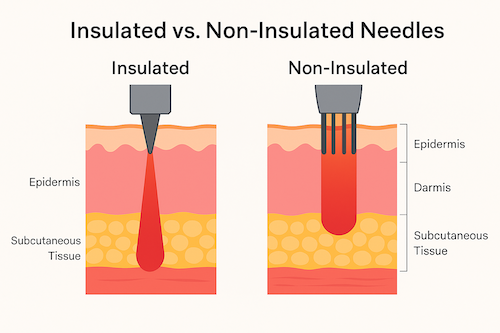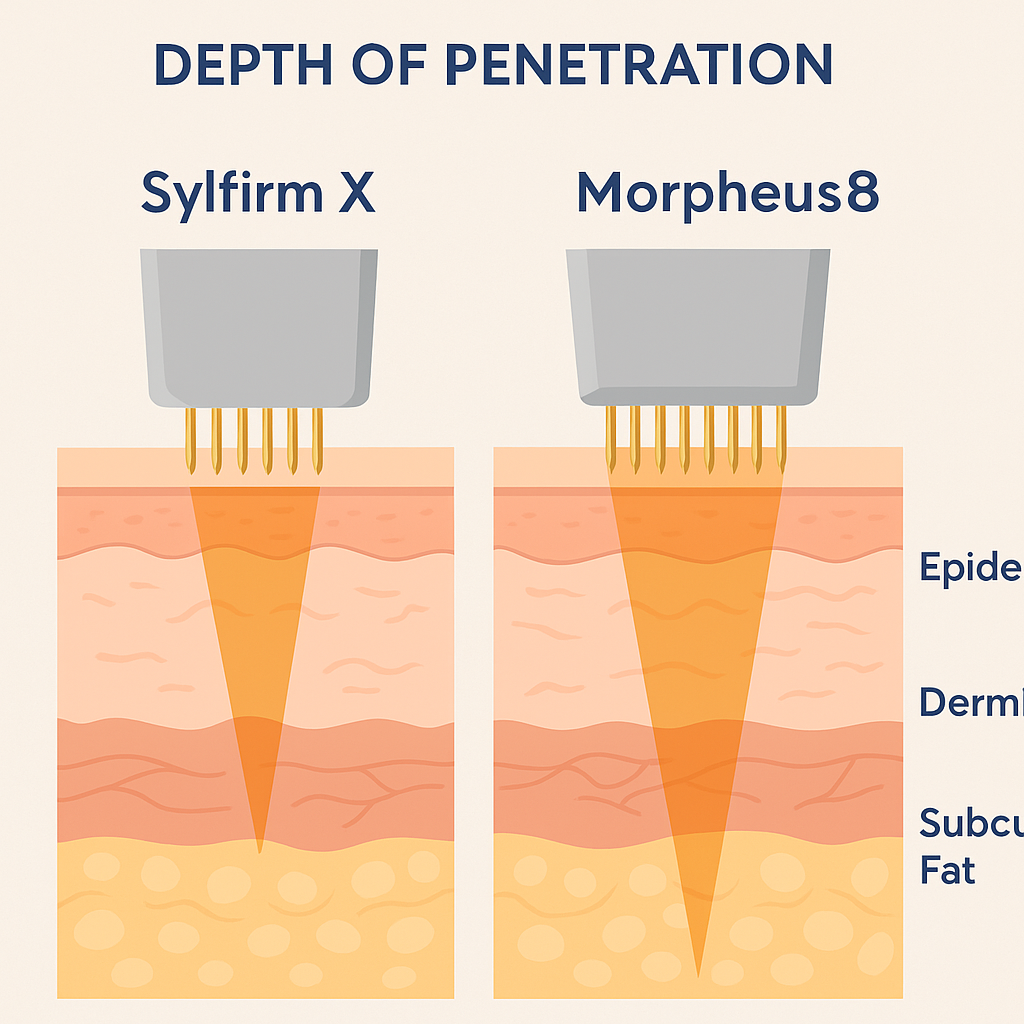Does RF Microneedling Burn Facial Fat

Can RF Microneedling Burn the Fat in My Face?
Many clients worry that RF microneedling could melt facial fat and cause unwanted volume loss—especially in the cheeks or under the eyes. This blog focuses on facial fat safety, how different devices like Sylfirm X and Morpheus8 behave at different depths, and how to avoid fat loss while still tightening the skin.
Looking for a full comparison of these two RF technologies? See our Sylfirm X vs. Morpheus8 comparison here
How RF Microneedling Works – Heat, Collagen & Skin Rejuvenation
RF microneedling is a combination of two treatments we love—microneedling and radiofrequency (RF) energy. They both help boost collagen and refresh the skin, but when combined in one device, they work better. Instead of just creating a superficial trauma as microneedling does, RF microneedling applies RF energy deep into your skin through the tips of tiny microneedles and delivers radiofrequency heat. Both aim to boost collagen, elastine and hyaluronic acid production, but the effectiveness of radiofrequency microneedling is 50 times higher.
Can RF Microneedling Cause Fat Loss?
The short answer: yes, RF microneedling can cause fat loss—but only under very specific conditions. Not all RF microneedling devices are designed to do this, but when certain settings are used, it can unintentionally affect the fat layer beneath the skin.
Here are the 3 main factors that can lead to facial fat loss during an RF microneedling treatment:
1. The RF Energy Reaches the Fat Layer
To melt fat, the RF energy needs to penetrate deep enough to reach the fat layer. It only happens when a device uses a frequency of 1 MHz or lower. Higher frequencies, like 2 MHz and above, don't go deep enough to impact fat—they stay more superficial, targeting only the skin's collagen layer. Therefore, if fat reduction isn't your goal, pay attention to the microneedling RF device's frequency. Explore full RF Microneedling benefits in Toronto here
2. Too Much Heat Concentrated in One Area
Another risk for fat reduction is when too much radiofrequency heat is delivered in one spot. It depends on the type of microneedles being used. Insulated needles allow heat to travel from the surface all the way down the full length of the needle—like a waterfall of energy—making it more likely to heat the fat layer. In contrast, non-insulated needles are designed to protect the upper layers ( zero risk of hyperpigmentation) and precise heat delivery to the specific skin depth like collagen, eliminating the risk of fat loss.
3. Long Heat Exposure (RF microneedling Pulse Duration)
The longer the skin is exposed to heat, the more likely it is to cause fat cell damage. Most RF microneedling devices let the practitioner adjust the pulse duration, which controls how long the heat is delivered. A long pulse means more sustained heat, which can increase the chance of fat melting, especially if combined with deep penetration and non-insulated needles.

See clinical results and real treatment outcomes that prove RF microneedling works: Does RF Microneedling Really Work? Clinical Proof & Results.
Under What Conditions RF Microneedling May Cause Fat Loss
RF microneedling can lead to fat loss—but only when all of the following are in place:
- The device uses a 1 MHz frequency (low enough to reach the fat layer)
- Insulated needles are used (allowing heat to spread through the full needle depth)
- Long pulses are applied (increasing heat exposure)
Choosing the correct device matters if you're not seeking face fat removal or reduction. Systems like SylfirmX use higher frequencies and non-insulated needles, making them a safe choice for skin tightening without the risk of radiofrequency fat loss in the face. Always ask your provider about their settings and device—your facial structure will thank you!

Explore the power of RF microneedling for collagen grows and skin tightening: RF Microneedling Toronto.
How Sylfirm X and Morpheus8 Differ in Terms of Facial Fat Impact?
Sylfirm X and Morpheus8 are advanced RF microneedling treatments—but they're built for different goals. Here's how they compare:
Morpheus8: Deeper & More Aggressive
- Designed to penetrate deep into the fat layer
- Morpheus8 is excellent for facial fat reduction, face contouring, and treating:
- Saggy cheeks
- Double chin
- Saggy Jowls
- Uses:
- Insulated needles
- 1 MHz frequency
- Longer and shorter pulses
- Best for younger patients with fuller faces or those wanting sculpting
Sylfirm X: Gentle & Precise
- Targets only the skin collage layer, avoiding fat
- Ideal for skin tightening and rejuvenation without fat loss
- Uses:
- Non-insulated needles
- 2 MHz frequency
- Shorter and longer controlled pulses
- Health Canada-approved for:
- Hooded eyelids
- Crow's feet
- Neck tightening
- Minimal downtime—just a few hours
- Perfect for peri- and menopausal women or those with thinner skin
Which Device Is Safer for Volume Preservation?
- Morpheus8 is best for fat contouring and reduction.
- Sylfirm X is ideal for safe, effective lifting and firming—especially if you want to preserve facial volume.

- Do you want more info, comparing Sylfirm X vs Morpheus 8 in Toronto?
Why Facial Volume Preservation Matters
It's completely normal to feel unsure whether RF microneedling could lead to facial fat loss—especially when trying to tighten your skin, not lose volume. The concern comes from how radiofrequency energy works: it heats the skin to boost collagen production, which helps smooth and firm the skin. But if that heat goes too deep, with special frequency and needle configuration, it can reach the fat layer—and in some treatments, that's the goal.
Devices like Morpheus8 are designed explicitly with needle configuration and specific RF settings that can melt fat, especially in the double chin and buccal fat areas. That's where the talk of face fat removal and radio frequency fat loss comes in.
Read our RF microneedling vs. Laser for skin rejuvenation for a full breakdown of comfort, downtime, and results.
Safe RF Options for Skin Tightening
The good news: not all RF microneedling devices behave this way. Systems like Sylfirm X and Scarlet are made to work safely within the collagen-only layer of the skin. Their design isn't meant for fat reduction—it's focused on firming, lifting, and improving skin texture, allowing it to work closely under the eyes and on the neck, areas with limited fat layers. So, if you're concerned about unintentional fat loss, Sylfirm X is an RF microneedling system that keeps your facial volume while rejuvenating your skin.
Read about RF microneedling costs in Yorkville here.
Last updated: June 2025 to reflect new RF device comparisons, safety guidelines, and clinical insights.
20+ years of medical aesthetic experience, nurse injections only, and a “natural, never overdone” approach in Yorkville Toronto.
FAQ
1. How to Melt Facial Fat?
Facial fat can be reduced using injectables or technology-based treatments. In Canada, the only approved injection for facial fat removal is Belkyra, which targets fat under the chin. Other options include: Radiofrequency fat reduction – uses heat to break down fat Fat freezing (cryolipolysis) – freezes fat cells to eliminate them naturally
2. Can You Reverse Facial Fat Loss?
Yes, facial fat loss can be reversed with dermal fillers to restore volume, or in some cases, by gaining weight.
3. How Much Does RF Microneedling Usually Cost?
Prices start at $300 for small areas and range from $500–$1,000 for full-face treatments, depending on the clinic and technology used.
4. Does RF Microneedling Cause Fat Loss in the Face?
RF microneedling can cause fat loss only if high-intensity settings are used at deeper penetration levels. Some devices may reach the subcutaneous fat layer, while others like Sylfirm X are designed to stay within the dermis, avoiding fat reduction.
5. Which RF Microneedling Device Is Safest for Preserving Facial Volume?
Sylfirm X is considered one of the safest options for clients concerned about facial volume. It uses controlled, non-insulated microneedles that target the dermis without affecting the fat layer underneath.
6. How Can I Prevent Unwanted Fat Loss From RF Microneedling?
Choose the right device, experienced provider, and treatment settings. Ask for treatments that stay within the dermis and avoid aggressive depths or excessive thermal energy.
7. Is RF Microneedling Better Than Lasers for People With Volume Loss?
Yes, RF microneedling like Sylfirm X can be a better option than lasers because it targets the dermis with minimal surface damage and without melting facial fat. Lasers can sometimes trigger collagen contraction affecting volume changes.
8. Can RF Microneedling Be Customized for Different Skin Concerns?
Absolutely. Devices like Sylfirm X offer various energy levels, depths, and pulse modes that can be tailored to treat pigmentation, laxity, redness, or texture—while protecting fat.



